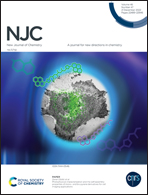Two new transition metal–organic frameworks as multiresponsive fluorescence sensors for detecting Fe3+, Cr2O72− and TNP†
Abstract
Two new transition metal–organic frameworks (MOFs) formulated as [Zn3(Bip)3(H2sip)2(H2O)4]·5H2O (CUST-751) and [Cd3(Bip)2(H2sip)2(H2O)4]·2H2O (CUST-752) [CUST = Changchun University of Science and Technology, Bip = 3,5-bis(imidazole-1-yl)pyridine and H2sip = 5-sulfoisophthalic acid monosodium salt] have been constructed via a solvothermal reaction. Their crystal structures have been characterized by single crystal X-ray diffraction. CUST-751 exhibits a two-dimensional (2D) layered structure, while CUST-752 possesses a three-dimensional (3D) framework. Thermogravimetric analysis (TGA) and powder X-ray diffraction (PXRD) after treatment at different temperatures and different relative humidities (RHs) verified that they both have good thermal stabilities and water stabilities. Besides, their utility as fluorescence sensors has also been investigated. The results indicated that both CUST-751 and CUST-752 can be used as multiresponsive fluorescence sensors to detect Fe3+ and Cr2O72− with good sensitivity, high selectivity and recoverability, even in the presence of other interfering ions. More interestingly, CUST-751 is capable of selectively detecting 2,4,6-trinitrophenol (TNP). This work provides insights into the design and synthesis of transition metal based MOFs and explores their potential applications in the fluorescence sensing field.



 Please wait while we load your content...
Please wait while we load your content...